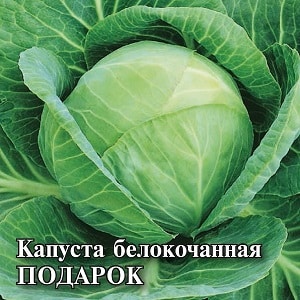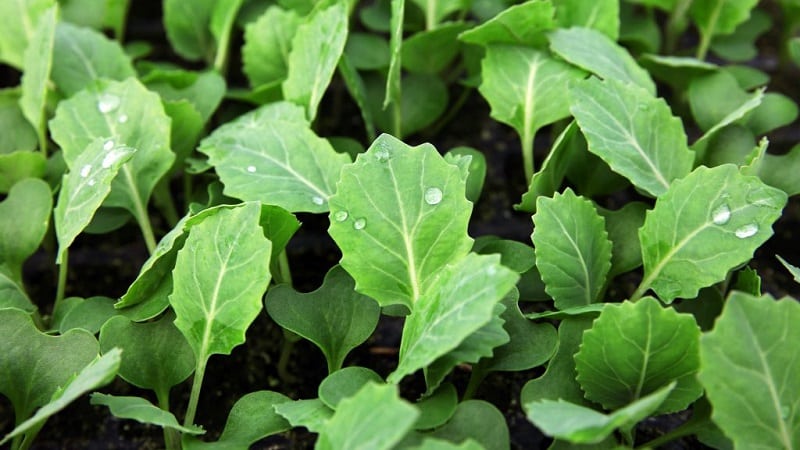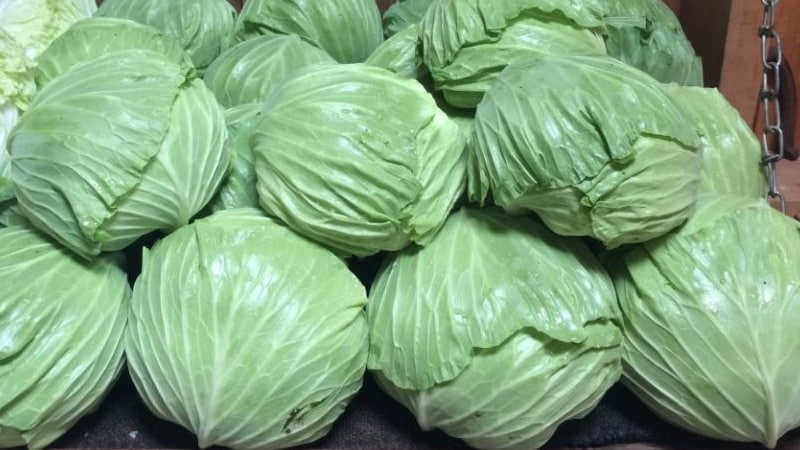Mid-late cabbage variety Podarok
Cabbage is considered one of the most unpretentious vegetables. It is resistant to cold and rich in vitamins, which is why almost every summer resident plants it in their garden. The variety of varieties allows you to make a choice. The gift was created just for mass sale. This variety was able to win hearts in a short time with its excellent taste and appearance.
Description of the cabbage variety Gift
This mid-late cabbage variety has excellent taste and commercial qualities., and is also resistant to pests, diseases and temperature changes.
Origin and development
The variety was bred by scientists from the All-Russian Research Institute for Selection and Seed Production of Vegetable Crops in the Moscow Region. In 1961 it was included in the State Register of Seed Material. Previously, numbers were also used in the name to indicate the variety, but in reality there was no difference between them.

Chemical composition and beneficial properties
Vegetable has the following composition per 100 g:
- 4.7-6.2 g – sugary substances;
- 26-41 mg – ascorbic acid.
The calorie content of this variety of cabbage is only 27 kcal., which makes it an indispensable product in health-improving diets.
Important! Sauerkraut contains 19 kcal per 100 g and is recommended as an essential product in the diet for problems with the gastrointestinal tract. Dietary fiber improves digestion.
Cabbage is rich in vitamins, as well as macro- and microelements (per 100 g):
- C – 45 mg (50%);
- B9 – 22 mcg (6%);
- potassium – 300 mg (12%);
- calcium – 45 mg (5%);
- magnesium – 16 mg (4%);
- cobalt – 3 mcg (30%).
The product is very important for baby food. Cabbage is one of the first vegetables introduced into complementary foods.
Features of application
Cabbage is used in the preparation of hot dishes, salads, baked goods and preparations.. Vitamins are preserved even when fermented or salting, so the heads of cabbage are used for harvesting for the winter.
Ripening period
The gift belongs to the mid-late varieties: 100-115 days pass from emergence to ripening. Within a month, the remaining heads of cabbage ripen.
Recommended for pickling leave the cabbage to ripen at temperature from +5 to –2°C and harvest at the first frost.

Productivity
Subject to compliance with agricultural technology from 1 sq. m harvest up to 9 kg. Under normal conditions, the average weight of a head of cabbage is 3-4 kg.
Cabbage has a very high ripening percentage, so approximately 99% of the total volume is ultimately considered salable.
Disease resistance
The gift shows resistance to major diseases, but Problems can arise if planting and care are improper. The most dangerous:
- clubroot - because of it, swellings appear on the roots, the growth of the plant is delayed, the foliage turns yellow, and if infected, the cabbage must be destroyed;
- downy mildew - darkening or plaque appears on the outside of the leaves;
- Fusarium - leaves wither and fall off, so infected plants are disposed of.
Cold resistance
Cabbage is a cold-resistant crop, and this variety is especially. He withstands short-term frosts down to –4°C.
Description of appearance and taste
Heads of cabbage are distinguished by a rosette that reaches a diameter of 100 cm. The leaves are smooth, spreading, slightly wrinkled along the edges.
Usually the heads of cabbage are round, but can be flat-rounded.The stalks are of medium length, the forks are dense and juicy. The leaves are gray-green in color, but the head is slightly yellowish when cut.
The taste is sweetish, so the variety is suitable for pickling.
For which regions is it best suited?
Due to its resistance to cold, this variety of cabbage is suitable for growing in any region. In the northern regions of Siberia or the Urals, seeds are planted under plastic bottles or film, and ideally seedlings are used.
Advantages and disadvantages of the Gift variety
Cabbage has many benefits, including:
 most seeds germinate after planting;
most seeds germinate after planting;- gives a stable harvest in any climatic conditions;
- long shelf life;
- excellent taste;
- attractive appearance for sale;
- preservation of properties during transportation;
- ideal pickling variety;
- resistance to cold and disease.
Among the shortcomings noted:
- dependence on moisture heads of cabbage die when the soil dries out for a short time;
- susceptible to pests - in improperly prepared soil, cabbage is often damaged.
Difference from other varieties and hybrids
The main difference from other varieties is frost resistance and cracking resistance.. They also note a long shelf life.
Features of planting and growing
It is important to properly prepare the seeds for planting, and also make sure that the soil is enriched with the necessary elements and is not depleted by its predecessors.
Preparing for landing
Cabbage variety Gift can be planted with seeds directly into the ground, and also prepare seedlings.
Seed preparation
Fresh seeds must be sorted and calibrated before planting.: ideal for sowing have a diameter of 2 mm. After this, they are soaked in a saline solution (30-50 g of salt per 1 liter of water) to weed out empty seeds.The solution is constantly stirred and any seeds that float are removed. Suitable planting material is washed abundantly with cool water.
To check germination, you need place 50-100 dried seeds on a dry part of the cloth, wet the other part and cover the seeds. In this form, they are removed to a place with a temperature of +15...+20°C and checked after 3 days: if more than 90% have sprouted, this batch is considered suitable for growing.
To disinfect planting material and protect against the development of fungal diseases, before disembarking you must:
- Crush 3 cloves of garlic, pour 50 g of boiling water.
- Wait until the infusion cools to +50°C, then place the seeds in the infusion for 1 hour.
- Dry the seeds on cloth or paper.
Preparing seedlings
If it is possible to prepare seedlings, it is better to choose this method, since the harvest will be better and ripening will occur earlier.
The prepared seeds are planted and grown for 1-1.5 months, after which moved into the ground. By this time the temperature should be +8…+15°C, night frosts are not allowed.

It is recommended to plant seedlings in cloudy weather or in the evening.. Each well is shed with 0.5 liters of settled water.
How to plant without seedlings
When planting without seedlings, it is important to choose the right place and high-quality soil.. Until the seeds sprout their first shoots, they need to be covered. Plastic bottles are ideal for this.
Soil requirements
The earth is loosened, after which Place the seeds in the furrows.
Important! If the ground is not sufficiently cultivated, planting should be done in holes, which are made by digging and loosening the soil.
Choose a well-lit place away from the shadows. Soil with low or neutral acidity, loosened before planting, and fertilized in the fall and spring is suitable.
Predecessors
The best predecessors for cabbage are considered:
- potato;
- tomatoes;
- cucumbers;
- legumes
It is not recommended to land after cruciferous vegetables, as cabbage becomes vulnerable to clubroot.
Important! The gift is not planted in one place more than once every 3-4 years.
Dates, scheme and rules of planting
In central Russia you can plant seeds from the end of April, adhering to the 5x5 cm pattern. The optimal depth is 1-1.5 cm.
Seedlings are planted on day 45, the optimal distance is 60x60 cm, since the heads of cabbage need room to grow. 2 weeks before planting, seedlings begin to harden, gradually increasing their exposure to fresh air.
Features of cultivation
For cabbage variety Podarok, soil composition is important: You can use a mixture consisting of turf soil, universal soil and coarse sand. Wood ash is also added to prevent pests.
It is important for seeds to provide regular air supply, so the bottles with which they are covered are lifted daily. They also monitor the soil moisture: if it is dry, it is sprayed with a spray bottle. The protective cap is removed when the first 3 leaves appear on the seedlings; This usually happens a month after planting.

Watering mode
Cabbage is a moisture-loving crop, so water it as needed so that the soil is always moist to a depth of about 70 cm. Add 3-4 liters of settled water at room temperature under the root.
Loosening and hilling
During the growth period, it is important to promptly loosen the soil around and make sure that weeds do not grow, which can ruin the plant.
Top dressing
At the beginning of the growing season, nitrogen fertilizers are applied to the soil; during the period of active growth, the plant needs phosphorus. Fertilizing is done after watering or rain.
The procedure is carried out three times:
- 2 weeks after planting - urea solution;
- after 5 weeks - potassium and phosphates;
- after 8 weeks - in case of soil depletion, potassium and superphosphate.
Disease and pest control
Among the most popular diseases are:
- kilou - diseased plants are destroyed, the soil is watered with Bordeaux mixture;
- peronosporosis - the soil and plant are treated with wood ash or a Fitosporin solution is used;
- cabbage white caterpillar - leaves are irrigated with infusion of ash or Intavir solution;
- cabbage flea beetle - heads of cabbage are treated with garlic infusion; in severe cases, chemicals are used (Anabasine).
The plant is susceptible to pest attacks, especially at an early stage of development.: Cruciferous flea beetles can quickly destroy tender foliage. To combat them, dusting is used, for which tobacco and wood ash are mixed 1:1.
To control other pests There are also several ways:
- when the cabbage fly attacks, the plant is destroyed, because it eats it at the roots; for prevention, ash or red pepper is added to the soil during loosening;
- to protect against snails and slugs, sprinkle the soil with lime or eggshells;
- cabbage butterfly caterpillars eat the leaves, treatment with chemicals will help prevent this;
- Caterpillars of white butterflies gnaw small holes on the leaves, and collect pests with their hands.
Difficulties in growing
To avoid problems, adhere to the following recommendations:
- cabbage is planted in one place no more than once every 3 years, predecessors are taken into account;
- favorable neighbors - onions and garlic, which repel pests with their smell;
- the land must be cultivated and fertilized;
- when signs of disease appear, disinfectant solutions are used;
- affected plants are promptly removed.
Harvest and storage
A mature head of cabbage is cut approximately 125 days after the first shoots, usually this happens in mid-October. The head of cabbage becomes hard and dense.
If you plan to pickle or ferment, you can wait until the first frost - the cabbage will be sweeter. The heads of cabbage are pulled out along with the roots, after which the stalk is cut off, leaving 4 cm.

Storage features and shelf life of the Podarok variety
Dense heads of cabbage must be stored. They are placed in a cold place (for example, to the cellar or basement), laying them out at a short distance from each other or hanging them by the stalk. The temperature is maintained no higher than +5°C, air humidity – 90%.
Important! Cabbage harvested in time can be stored for 6-7 months.
Reviews from experienced gardeners
Most reviews about Podarok cabbage are positive. Summer residents note its unpretentiousness, good germination and pleasant taste.
Tatiana, Tula: “This is a favorite variety in our family because it is unpretentious and stores very well. The heads of cabbage lie in the cellar until spring. We also make sure to ferment it for the winter. There were problems with watering one year - they didn’t pay attention, and several heads of cabbage withered, but then they became more attentive.”.
Alexey, Tambov: “I’ve been growing this cabbage on my plot for several years. I like that it takes root easily and grows well. Medium-sized heads of cabbage - 3 kg, I would like more. But overall I’m happy with everything – both the yield and the taste.My wife always praises cabbage rolls, they are easy to make, but for me, they are perfect for pickling«.
Conclusion
The variety of white cabbage Podarok is valued by summer residents for its sweetish taste, as well as for its high yield at low cost of seeds. To obtain a high-quality harvest, it is important to properly care for the plant and not forget about timely pest control treatments. Gift cabbage can be stored for the winter for personal use or sold due to its attractive presentation.